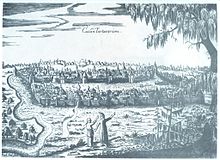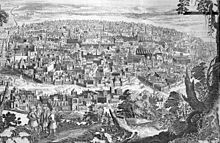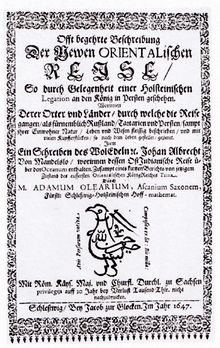Adam Olearius

Adam Olearius (actually Oehlschlegel or Ölschläger ; baptized September 24, 1599 in Aschersleben ; † February 22, 1671 at Gottorf Castle , today in Schleswig ) was a German writer , scholar and diplomat . He was buried in the Dreifaltigkeitskirche in Schleswig .
Life
Adam Olearius was the son of the tailor Adam Oehlschlegel and his wife Maria Porst. He grew up in simple circumstances. Nevertheless, in 1620 he managed to enroll at the University of Leipzig for the subject of theology. He also studied philosophy and mathematics on the side. In 1627 Olearius was awarded the title of Magister in Philosophy and five years later, during which he taught first at the Nikolaischule and then at the Thomas School , he advanced to the position of assistant in the philosophy faculty in Leipzig. He was also promoted as a member of the Smaller Prince Foundation.
Travel to Russia and Persia
In 1633 he switched to the service of Duke Friedrich III. from Schleswig-Holstein-Gottorf . The duke planned an economic connection between northern Germany and Russia . Therefore, he equipped an embassy, which started on November 6, 1633 in Altona under the direction of the merchant Otto Brüggemann and the ducal councilor Philipp Crusius . The first destination of this delegation was Moscow , where it arrived on August 14, 1634. The delegation consisted of 120 people and Olearius was its secretary. The mission's aim was to reach a trade agreement with Tsar Mikhail Fyodorovich Romanov . Since the tsar had extremely unrealistic ideas about the customs revenue he was entitled to, the mission failed in its actual mission.
Nevertheless, immediately after returning to Gottorf on April 6, 1635, preparations for another expedition to the Persian court began. This should lead to a trade agreement with Persia and move the Safavids ruling there to an alliance against the Ottomans . Otto Brüggemann and Philipp Crusius also led this trip, while Olearius was again the secretary. They were u. a. accompanied by the traveler Johann Albrecht von Mandelslo and the poet and physician Paul Fleming . On October 22, 1635, they started again in Altona, embarked in Travemünde , reached Moscow on March 29, 1636 and continued the journey on June 30 of the same year via Nizhny Novgorod down the Volga . In Astrakhan on October 10th, they wanted to cross the Caspian Sea by means of a self-built ship , but were shipwrecked near Derbent . On December 22nd, 1636 the journey continued overland. On December 30th, the embassy reached Shamacha , the capital of the province of Shirvan ; there she paused until March 27, 1637. During this time, Olearius carried out astronomical localizations, met with local scientists and learned Persian . On August 3, 1637, the delegation finally reached the capital, Isfahan . Since the members - above all Otto Brüggemann, apparently - behaved in an extremely high-handed manner and snubbed the Safavids, the mission soon failed. On December 21, 1637, the embassy left for home without having achieved anything. Johann Albrecht von Mandelslo separated from the group and traveled on to India. The rest of the group traveled on an arduous route through the Elburs Mountains and reached the Caspian Sea again on June 14, 1638. From here on the further return journey was like the outward journey. Olearius separated from the group because of serious quarrels with Brüggemann and traveled ahead from Reval . Brüggemann himself returned to Gottorf with the rest of the tour company on August 1, 1639. He was blamed for the complete failure of the mission and the financial losses alone - although it appears that Crusius was the leader of the expedition - and therefore sentenced to death and publicly executed on May 5, 1640 for incompetence.
Olearius published detailed travelogues about both trips (1647). With this report he founded the scientific travelogue in Germany. At the same time he corrected the view held since Ptolemy that the Caspian Sea had its greatest extent in an east-west direction, correctly in a north-south direction. His translations from Persian are also of great importance.
At the Gottorfer Hof
1639 was Olearius by Duke Friedrich III. appointed court mathematician. Ten years later, Olearius also became court librarian. As such, he was also entrusted with building the Gottorfische Kunstkammer, which still exists today . After his travel companion Crusius had married the merchant's daughter Maria Möller in 1639, who had visited her father's house in Reval several times, Olearius married her sister Catharina a year later. With her he had three daughters and a son. In 1644 the duke provided him with building land and wood for a house in Schleswig-Friedrichsberg near Gottorf Castle .
In 1651, Duke Wilhelm IV of Saxe-Weimar accepted Olearius into the Fruitful Society . The Duke gave him the company name of the hard-working and the motto in a foreign country . The Muscovite bitter orange was assigned to him as an emblem . Olearius' entry can be found in the Koethen society register under the number 543. In accordance with the society’s obligation to publish, he composed the epigram:
- If a scholar will not put the art to work
- so it will be like clouds without rain.
As a court mathematician, he became known far beyond the borders in 1654 when he constructed the so-called Gottorf giant globe with a diameter of 3.00 m.
Olearius also took care of the church by translating the previously Low German agendas into High German. This agende appeared in 1665 and was in use in Schleswig-Holstein's churches until the introduction of the rationalist agendas conceived by Jacob Georg Christian Adler , sometimes even longer, and was reprinted in 1850.
Adam Olearius also published the travel reports of Jürgen Andersen and Volquard Iversen in 1669 under the title "Orientalische [n] = travel descriptions".
Works
- Selected poems , ed. Wilhelm Müller , Leipzig 1822 (Library of German poets of the 17th century, 9)
- Funny history of where tobacco drinking comes from . Schleswig, 1643.
- Increased Newe Description of the Muscowite and Persian Reyse This happened through the occasion of a Holstein embassy to the Russian Tsar and King in Persia. Schleswig 1656 (Reprint Tübingen: Niemeyer 1971) ( digitized Munich )
- Muscovite and Persian journey: the Holstein embassy 1633–1639 . Schleswig 1656, Repr. Stuttgart: Thienemann, 1986, ISBN 3-522-60650-7 .
- Kurtze remembrance and report of the great and terrible solar eclipse of this 1630th year, the last May ... be seen , Leipzig 1630 ( digitized Wolfenbüttel )
- Often coveted description of the Newen Oriental Journey / So it happened through the opportunity of a Holstein legation to the king in Persia: Wherein their places and countries / through which the journey went / as fornemblich Russia / Tartaria and Persia / sampt their inhabitants nature / life and beings diligently described / and with many copper pieces / so placed after life / adorned / by M. Adamum Olearium, Ascanium Saxonem, Fürstl: Schleßwig-Holsteinischen Hoff-mathemat. Item A letter from WolEdeln [et] c. Johann Albrecht Von Mandelslo: which contains his East Indian journey across the Oceanum; Compilation of a brief report of the current state of the very first Oriental King Empire Tzina , Schleswig 1647 ( digitized and full text in the German text archive , digitized Wolfenbüttel )
- Persian Rosenthal Hamburg 1654 ( digitized Wolfenbüttel )
- Detailed description of the known Reyse to Muscow and Persia. For example, by the occasion of a Holstein embassy from Gottorff to Michael Fedorowitz the great Zaar in Muscow / and Schach Sefi König in Persia ... , Schleswig 1663 digitized Wolfenbüttel
- Gottorfische Kunst-Cammer , Schleswig 1666 (digitized Wolfenbüttel: part 1 , part 2 )
In his literary work, Olearius often used the following pseudonyms: Ascanius Olivarius , Ascanius d'Oliva , AdOnis , Adonis Sleidanus , or AOnides .
literature
- Kirsten Baumann / Constanze Köster / Uta Kuhl: Adam Olearius. Curiosity as a method (proceedings for the international conference "The Gottorf scholar Adam Olearius. Curiosity as a method?", Schleswig 2015). Michael Imhof Verlag, Petersberg 2017, ISBN 978-3-7319-0551-6 .
- Faramarz Behzad: Adam Olearius Persianischer Rosenthal: Investigations into the translation of Saadi's "Golestan" in the 17th century . Vandenhoeck & Ruprecht, Göttingen 1970.
- Elio C. Brancaforte: Visions of Persia: mapping the travels of Adam Olearius. Harvard University Press, Cambridge MA 2003, ISBN 0-674-01221-6 .
- Eckardt Opitz : Adam Olearius In: Those are our treasure and wealth. 60 portraits from Schleswig-Holstein . Christians, Hamburg 1990, ISBN 3-7672-1115-7 , pp. 36-40.
- F. Prinz: From the histories of foreign peoples: Adam Olearius' legation trips through Russia and Persia. In: Back then. Volume 24, 1994, pp. 850-866.
- Karl Rauch: Silk Road via Moscow: Adam Olearius' great journey to Moscow and Isphahan between 1633 and 1639. Pfeiffer, Munich 1960.
- Gerhard Dünnhaupt : Adam Olearius (1599–1671). In: Personal bibliographies on Baroque prints. Volume 4, Hiersemann, Stuttgart 1991, ISBN 3-7772-9122-6 , pp. 2979-3004.
- Claus Priesner: Olearius, Adam. In: New German Biography (NDB). Volume 19, Duncker & Humblot, Berlin 1999, ISBN 3-428-00200-8 , pp. 517-519 ( digitized version ).
- Friedrich Ratzel : Olearius, Adam . In: Allgemeine Deutsche Biographie (ADB). Volume 24, Duncker & Humblot, Leipzig 1887, pp. 269-276. and the corrections at the end of the article
- Olearius (Adam). In: Johann Heinrich Zedler : Large complete universal lexicon of all sciences and arts . Volume 25, Leipzig 1740, column 1166 f.
- Er - Gruber : General Encyclopedia of Sciences and Arts . FA Brockhaus, Leipzig 1832, 3rd section, 3rd part, p. 37. ( online )
Olearius' life was treated literarily in Erich Maletzke: A Turbulent Life. Adam Olearius. Gottorf court scholar . A documentary novel; Wachholtz Neumünster 2011
Olearius is mentioned in Daniel Kehlmann's novel Tyll (2017), where he is on the road with Athanasius Kircher , accompanied by Paul Fleming . They argue in a carriage during a trip. All three meet Tyll Ulenspiegel .
See also
Web links
- Literature by and about Adam Olearius in the catalog of the German National Library
- Publications by and about Adam Olearius in VD 17 .
- Digitized prints by Adam Olearius in the catalog of the Herzog August Library
Individual evidence
- ^ Aschersleben baptismal register, St. Stephani
- ↑ Crusius was later named governor in Estonia, Sweden .
- ↑ Erich Kuhlmann: Moscowitische travel description of Adam Olearius. A 17th century Holstein embassy at the Tsar's court. In: Journal Archive for German Postal History. Issue 2/1973 (Editor: Georg Lechner), Frankfurt am Main 1973, ISSN 0003-8989 , pp. 136–155.
- ^ Claus Priesner: Olearius, Adam. In: New German Biography (NDB). Volume 19, Duncker & Humblot, Berlin 1999, ISBN 3-428-00200-8 , pp. 517-519 ( digitized version ).
- ^ Daniel Kehlmann: Tyll . Rowohlt, Reinbek 2017, pp. 347–393.
| personal data | |
|---|---|
| SURNAME | Olearius, Adam |
| ALTERNATIVE NAMES | Oehlschlegel, Adam; Oil hammer, Adam |
| BRIEF DESCRIPTION | German diplomat and writer |
| DATE OF BIRTH | baptized September 24, 1599 |
| PLACE OF BIRTH | Aschersleben |
| DATE OF DEATH | February 22, 1671 |
| Place of death | Gottorf Castle , today part of Schleswig |





